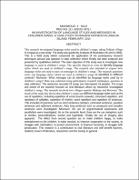| dc.description.abstract | This research investigated language styles used in children’s songs, taking Ndijani village in Unguja as a case study. The study was guided by Analysis of illustration of Leech (1969). This is a field study which comprised the application of the participatory research techniques perusal and question in data collection which finally has been analyzed and presented by qualitative method. The main objective of this study was to investigate how language is used in children’s songs. The specific objectives were to identify language styles which are used in children’s songs. The research also intended to expose how language styles are used to pass on messages in children’s songs. The research questions were; can language styles which are used in children’s songs be identified in different contexts? Moreover, What messages can be identified by language styles used by in children’s songs? Data was collected using participatory research techniques, question in data collection. The researcher recorded 25 songs and interviewed 18 peoples. The scope and extent of the research focused on oral literature where by researcher investigated children’s songs. The research involved two villages namely Mtakuja and Mseweni. The result of the study has shown that children’s songs use different language styles such as the use of repetition, including repetition of vocal sounds (vowels), consonant repetition, and repetition of syllables, repetition of rhythm, word repetition and repetition of sentences. This included of grammar such as short sentences (simple), command sentences, question sentences and statement sentences. Also long sentences such as compound and complex sentences were investigated. Moreover, the use of ungrammatical expressions and parallelism were investigated. As on the semantic level, there are the use metaphors such as similes, personifications, ironies and hyperbole. Finally the use of imagery also appeared. The effect from second question are to make children happy, to make entertainment to the children, it make musical, to improve cooperation to the society, to struggle with colonialism, to protect environment, to improve humanity, to struggle with persecution. This research is a contribution to oral literature and will benefit teachers, students, lovers of literature, researchers and the society in general. | en_US |

